Are you ready to make your tricep workout even better? Look no further than the well-known exercise called skull crushers.
Skull crushers, also known as lying triceps extensions, are isolation exercises that work the triceps brachii muscle.
The name “skull crusher” comes from the exercise’s mechanics: bringing the weight down to the skull from an overhead position.
Barbell skull crushers are a popular type of skull crusher among gym goers and bodybuilders. There are many other variations of skull crusher that you can use to maximize tricep stimulation.
- Dumbbell Skull Crusher
- Cable Skull Crusher
- Ez Bar Skull Crusher
- Incline Skull Crusher
- Decline Skull Crusher
You can also perform the skull crushers by changing the bench position either incline or decline.
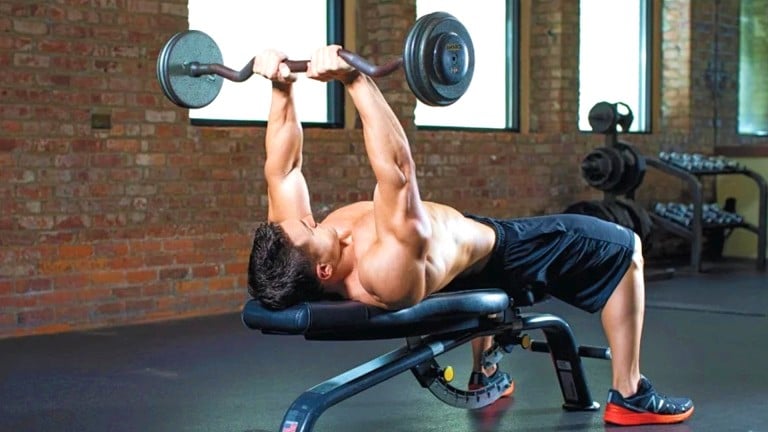
- Skull Crusher Muscles Worked
- How to Do Skull Crushers
- Tips and Proper Form
- Best Skull Crusher Variations
- 1. Barbell Skull Crusher
- 2. Incline Skull Crusher
- 3. Decline Skull Crusher
- 4. Cable Skull Crusher
- 5. Dumbbell Skull Crusher
- 6. Reverse Grip Skull Crusher
- Benefits of Skull Crushers
- FAQs
- Are skull crushers good?
- Skull crushers hurt my elbows. What should I do?
- How much weight should I use for Skull Crushers?
- Can you do Skull Crushers without a bench?
- Do skull crushers build mass?
- References
Skull Crusher Muscles Worked
- Skull crushers primarily work the triceps brachii (the long head, the lateral and medial heads of the triceps)
- The forearm muscles, specifically the brachialis, brachioradialis, and forearm flexor muscles, act as stabilizers during skull crushers.
- In addition to targeting the tricep, the skull crushers involve several synergist and stabilizer muscles: the pectoralis major, anterior deltoid, lats, and Biceps Brachii.
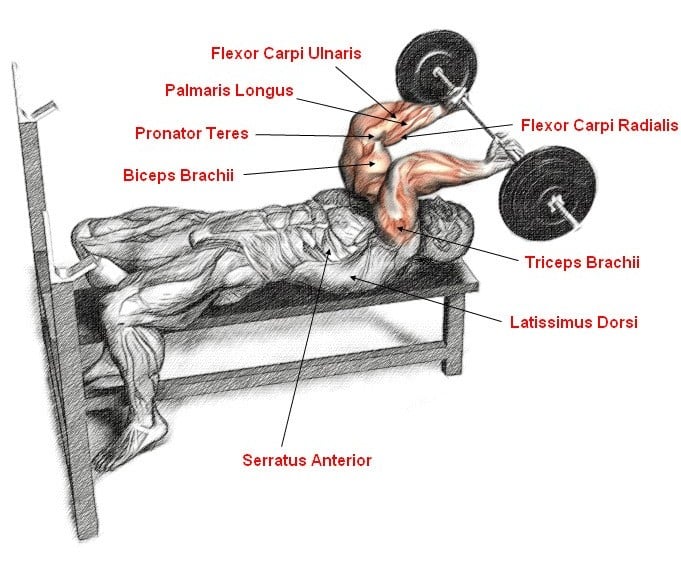
How to Do Skull Crushers
- Lie down on a flat bench with your feet firmly planted on the ground.
- Ensure your head, upper back, and buttocks are in contact with the bench.
- Pick a weight, such as dumbbells or a barbell, for the workout. Choose the weight that is suitable for you.
- If using a barbell or EZ-curl bar, grip it with an overhand grip slightly wider than shoulder-width apart.
- If using dumbbells, hold them with a neutral grip (palms facing each other).
- Extend your arms straight above your chest, perpendicular to the floor.
- Bend your elbows and slowly lower the weight towards your forehead.
- Control the movement and aim to bring the weight to a point just above your forehead without touching it.
- Pause briefly at the bottom position, feeling the stretch in your triceps.
- Then, lift the weight back up by extending your elbows until your arms are fully extended. Don’t lock your elbows at the top.
- Perform 3–4 sets of 8–12 repetitions.
Tips and Proper Form
- Avoid lowering the weight too close to your face or forehead. This can put too much strain on the elbows and increase the risk of getting hurt.
- If you are new to this exercise, you should start with a lightweight and work on perfecting your form. As you get used to the exercise and get stronger, you can slowly increase the weight you use.
- The entire movement should be performed slowly and with control, especially when the weight is moving behind the head.
- Focus on your breathing. Exhale as you lift the weight back up, and inhale as you lower it down towards your forehead.
- Keep your elbows close to your head and pointing upward.
- Keep your shoulders and upper arms fixed. All the movement should be in your elbows.
- Prevent your elbows from flaring out to maintain proper form.
- Don’t lock your elbows at the top of the movement. This can put stress on your elbows and lead to injury.
- Pause for a moment at the bottom of the movement. This will help to stretch the triceps and get a better workout.
- Start light, add weight gradually, and always keep the movement under full control.
- If using a barbell or EZ-curl bar, grip it with an overhand grip slightly wider than shoulder-width apart. If using dumbbells, hold them with a neutral grip (palms facing each other).
- Select sets and rep ranges for muscle growth and hypertrophy, as given below.
| Goal | Sets | Reps | Rest Between Sets |
|---|---|---|---|
| Muscle Growth | 3 to 4 | 8 to 12 reps | 60 to 90 seconds |
| Endurance | 3 to 4 | 15 to 20 reps | 30 to 45 seconds |
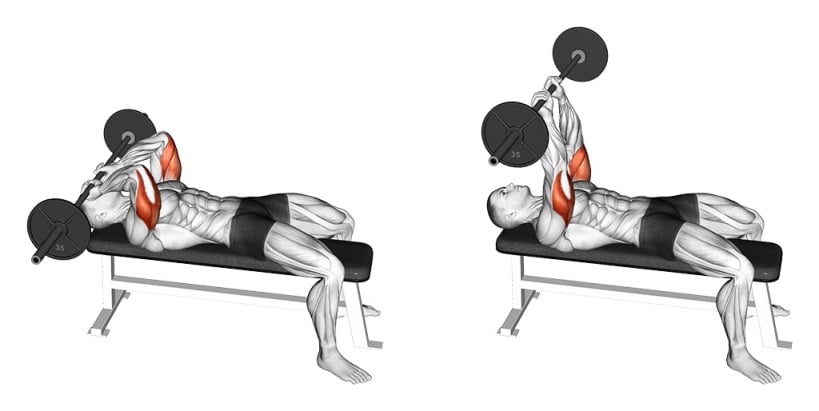
Best Skull Crusher Variations
There are many variations of skull crusher that you can do with dumbbells, cable a standard barbell, or by changing bench position.
The skull crusher can be done in different ways to suit your fitness level.
- If you are new to performing a skull crusher, you may want to apply a few modifications to make the exercise easier. One way to counter this problem is to use a lighter weight. Another is to dumbbell and cable skull crunches.
- If you want a more advanced variation to stimulate different muscle fibers in the tricep, try Incline and Decline Skull Crushers.
Below are 6 skull crusher variations that coaches and athletes can use to keep training varied and progressive.
1. Barbell Skull Crusher
The barbell skull crusher is a popular variation of the skull crusher exercise that targets the triceps muscles.
The barbell lets you lift heavier weights, leading to greater strength gains and muscle stimulation.
The barbell can be used for different types of skull crushers, such as close-grip, wide-grip, and EZ-bar.

How To Do
- Lie down on a flat bench, spread your legs, and plant your feet flat on the floor for stability.
- Grasp the barbell about shoulder-width apart with your hands and your thumbs wrapped around the bar.
- Extend your arms straight above your chest, perpendicular to the floor.
- Keep your elbows stationary and slowly lower the barbell towards your forehead.
- Exhale as you press the barbell back up to the starting position.
Know More: 7 Best Barbell Triceps Exercises For Mass And Strength
2. Incline Skull Crusher
The incline skull crusher helps to build muscle and strength in all three tricep heads.
The incline position allows for a deeper triceps stretch during the eccentric (lowering) phase and a more intense contraction during the concentric (lifting) phase.
Adding incline skull crushers to your tricep workout routine can help you strengthen and overcome plateaus.
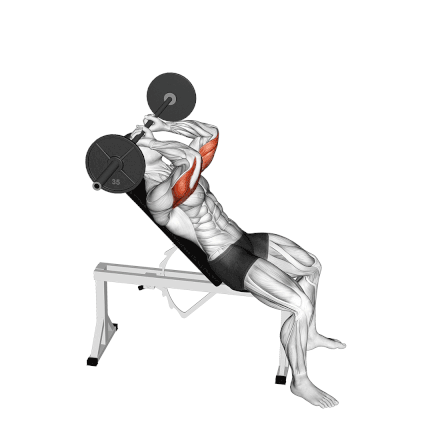
How To Do
- Set an incline bench at around 30–45 degrees.
- Take an EZ Bar and lie on a bench with your face facing up and your feet on the floor.
- Extend your arms over your shoulders with your palms facing up.
- Keep your upper arms fixed, with your elbows close to your head.
- Then, slowly lower the weight towards your forehead.
- Hold this position for a count, and then raise your arms to the starting position.
3. Decline Skull Crusher
Decline skull crushers are a variation of the traditional skull crusher exercise that is performed on a decline bench.
The decline position makes the exercise slightly more challenging. This can lead to greater triceps strength and muscle gains over time.
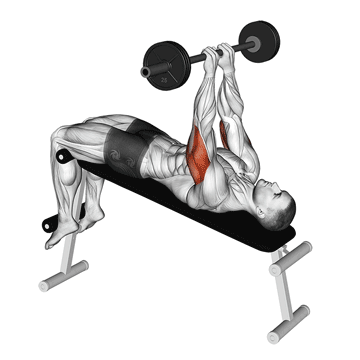
How To Do
- Grab a barbell and lie on a decline bench with your feet firmly on pads.
- Extend your arms over your shoulders with your palms facing up.
- Then slowly lower the barbell behind your head by bending your elbows.
- Hold this position for a count. Then raise your arms back to the starting position.
- At the top of the movement, do not lock out your elbows.
4. Cable Skull Crusher
Unlike other variations of skull crushers that rely on gravity, lying cable skull crushers maintain constant tension on the triceps throughout the entire range of motion.
The cable skull crusher helps you maintain tension throughout the range of motion. This works your triceps from start to finish.
There are several variations of cable skull crushers that you can incorporate into your triceps workout routine.
- Single-arm cable skull crushers
- Rope cable skull crushers
- Reverse Grip Skull crusher.
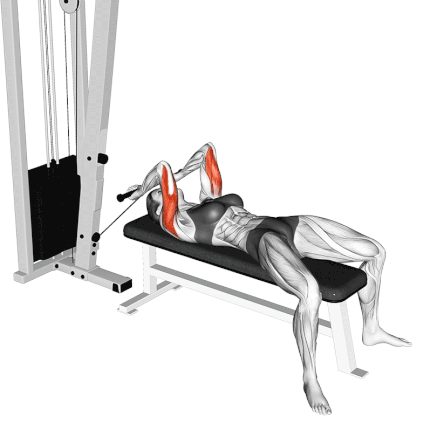
How To Do
- Position a bench close to a low cable pulley, with the head of the bench nearest to the pulley.
- Lie on your back (supine) on the bench. Grasp the bar with a shoulder-width pronated (overhand) grip.
- Press the bar upward until your arms are fully extended, and hold the bar over your forehead so that your arms are slightly slanted backward.
- Keep your elbows straight and exhale as you bend your elbows and lower the bar to your forehead.
- Exhale as you extend your elbows to raise the bar back to the starting position.
5. Dumbbell Skull Crusher
Dumbbell skull crusher is a popular exercise that primarily targets the triceps muscles. It allows you to work each arm independently, which helps to correct muscle imbalances and ensure balanced triceps development.
Dumbbells also allow you to adjust your grip and range of motion based on your comfort and flexibility.
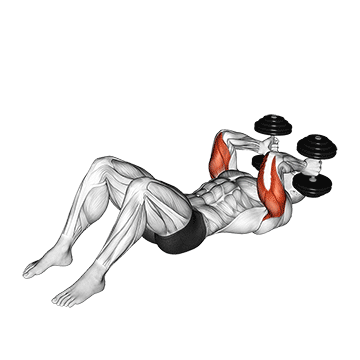
How To Do
- Lie on your back on the bench/floor with your feet on the floor straight and shoulder-width apart.
- Hold a dumbbell in each hand with the elbows bent and pointing toward the ceiling.
- Extend the elbows until the arms are straight in the air.
- Pause. Reverse the movement to return to the start position. Repeat for the desired number of repetitions.
Know More: 10 Best Dumbbell Triceps Exercises for Mass & Strength
6. Reverse Grip Skull Crusher
Reverse skull crushers are a remarkable tricep exercise because they encourage you to keep your elbows tucked in rather than flared out.
While this elbows-in-lifting technique certainly trains the triceps well, performing reverse grip skull crushers is actually dangerous unless you use lifting straps or Versa Grips to keep the bar secure.
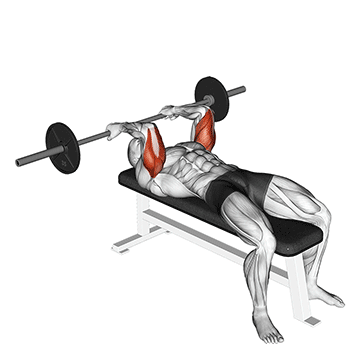
How To Do
- Grab the bar with a supinated grip and wrap your lifting straps securely around the bar.
- Lie back on the bench and press the bar up to position it over your forehead.
- Lower the bar behind your head by breaking at your elbows.
- Allow enough backward shoulder movement to get an intense stretch in the long (inner) head of your triceps.
- Reverse the motion by extending your elbows until they reach complete lockout.
- Repeat for as many reps and sets as desired.
Benefits of Skull Crushers
Skull crushers work the triceps muscle through a deep range of motion. This is great for building muscle.
There are numerous other advantages of doing skull crushers.
- Skull crushers work the triceps, which will help protect your elbow joints in other settings.
- It can help improve complex movements such as the bench press and add mass to the triceps.
- Studies have shown that the triceps play a critical role in throwing movements, enhancing overhead throwing power.
- To do skull crushers, you must move your arms to full range of motion. This can make your shoulders and elbows more flexible and move freely.
- The skull crusher exercise can be a good alternative to the standing overhead triceps extension if you are experiencing pain or difficulty with overhead exercises.
- A study conducted in 2020 revealed that a specific triceps exercise could enhance the strength of the bench press.
- Strengthening your triceps is a great way to improve your functional fitness.
- Skull crushers offer versatility as you can perform it with a dumbbell, barbell or an EZ curl bar.
FAQs
Are skull crushers good?
The Skull Crusher is a great triceps exercise that can be done at the gym. And you can also do the dumbbell skull at home with a pair of dumbbells. The DB skull crusher is a more difficult variation of the classic skull crusher.
Skull crushers hurt my elbows. What should I do?
I doubt they are skull crushers. If you are experiencing any pain, you should seek medical attention immediately. However, it is a good rule of thumb to avoid something if it hurts, even if it is not typical muscle soreness from a workout.
You could also try variations of cable exercises, like tricep pushdowns. These kinds of movements tend to be easier on the elbow and shoulder joints.
How much weight should I use for Skull Crushers?
Start with a light weight and build up over time. Make sure you focus on form and technique first.
You should also give your shoulders, wrists, and forearms time to develop their strength.
Can you do Skull Crushers without a bench?
Yes, you can perform skull crushers without a bench by lying down on the floor.
Do skull crushers build mass?
Skull crushers combined with pressing movements help us build bigger arms and get balanced muscle growth. The skull crusher is an effective way to work all three heads of your triceps.
References
- Boehler B, Porcari JP, Kline D, Hendrix R, Foster C, Anders M. ACE-sponsored research: Best triceps exercises. American Council on Exercise.
- Borges E, Mezêncio B, Pinho J, Soncin R, Barbosa J. Resistance training acute session: pectoralis major, latissimus dorsi and triceps brachii electromyographic activity. J Phys Ed Sport. 2018;2018(02):648-653. doi:10.7752/jpes.2018.02095
- Alves D, Matta T, Oliveira L. Effect of shoulder position on triceps brachii heads activity in dumbbell elbow extension exercises. J Spors Med Phys Fitn. 2017;58(9):1247-52. doi:10.23736/s0022-4707.17.06849-9
- Shuttlewood K, Beazley J, Smith CD. Distal triceps injuries (Including snapping triceps): A systematic review of the literature. World J Orthop. 2017;8(6):507-513. doi:10.5312/wjo.v8.i6.507
- American Council on Exercise. ACE Study Identifies Best Triceps Exercises.

Manish is a NASM-certified fitness and nutrition coach with over 10 years of experience in weight lifting and fat loss fitness coaching. He specializes in gym-based training and has a lot of knowledge about exercise, lifting technique, biomechanics, and more.
Through “Fit Life Regime,” he generously shares the insights he’s gained over a decade in the field. His goal is to equip others with the knowledge to start their own fitness journey.
